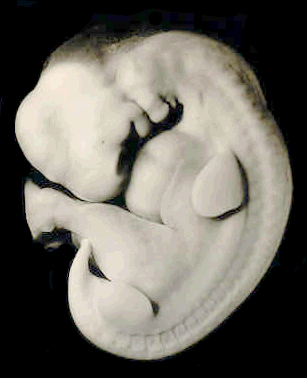
𝐒𝐨𝐦𝐞 𝐨𝐛𝐬𝐞𝐫𝐯𝐚𝐭𝐢𝐨𝐧𝐬 𝐨𝐧 𝐭𝐡𝐞 𝐦𝐮𝐝𝐠𝐡𝐚𝐡 (𝐜𝐡𝐞𝐰𝐞𝐝-𝐥𝐢𝐤𝐞) 𝐬𝐭𝐚𝐠𝐞 𝐨𝐟 𝐡𝐮𝐦𝐚𝐧 𝐝𝐞𝐯𝐞𝐥𝐨𝐩𝐦𝐞𝐧𝐭 𝐀𝐬 𝐝𝐞𝐬𝐜𝐫𝐢𝐛𝐞𝐝 𝐢𝐧 𝐓𝐡𝐞 𝐆𝐥𝐨𝐫𝐢𝐨𝐮𝐬 𝐐𝐮𝐫𝐚𝐧


Figure 1: Left lateral view of an embryo at Carnegie stage 14 (about 32 days). Photograph from the Carnegie Collection
The Qur’an mentions the term mudghah مُضْغَةً as the third stage of human prenatal development. The word mudghah has several meanings: “something that has been chewed by the teeth”, “a piece of meat of a size that can be chewed” and “the small substances.” These meanings were described in a previous post: Embryology in the Qur’an: The Mudghah Stage.
In this post I highlight some observations regarding the meaning of mudghah as “something that has been chewed by the teeth”.

Figure 2: Human embryo at Carnegie Stage 14, day 32 with 35 somites. The embryo is about 7.0 mm in length. Note the indentations that are identified between somites, and with these indentations, the embryo resembles a chewed substance in its external appearance
In Figure 2 above, the embryo looks somewhat like a chewed lump. The chewed appearance results from the somites which resemble teeth marks. The somites (cuboidal blocks of mesodermal tissue) represent the beginnings or primordia of the vertebrae. By the 3rd week of human embryonic development about 38 pairs somites form.
By the 5th week there are 42-44 pairs of somites. Most of the axial skeleton (skull, vertebral column, ribs, and sternum) and skeletal muscles will be derived from these somites. The appearance of the somites or “imprints” changes continuously, just as the teeth imprint changes on a chewed substance with each act of chewing. And just as a substance acquires furrows, swellings and a corrugated surface as it is being chewed, so does the appearance of the embryo.

Figure 3 shows a piece of gum that has been shaped like an embryo and then chewed. During the act of chewing, the dental impressions form an imprint of the teeth on both sides of the gum as shown in Figure 4. The teeth imprints and their segmental arrangement are said to resemble the somites of an embryo. The human embryo is also said to be segmented and the segments of the embryo consist of somites, the cell masses which develop into ribs, vertebrae and back muscles.[2]

As there were no microscopes available in the 7th century CE, people would not have known that the human embryo had this chewed-like appearance. Professor Marshall Johnson states:
“You have to be really careful on what is the definition of ‘seeing’. I can see a piece of dandruff on this tabletop; I can just barely make it out because this is a nice black surface [but] I can see no detail in it. If I want to see detail in it then I need some sort of visual aid, something to aid my vision, I need a magnifying glass, I need a microscope. So I might be able to see a piece of dandruff, but to see any detail in it as is described in the Qur’an, I need an instrument that wasn’t developed until the 1700s.” [4]
NOTES
[1] Adult teeth image modified from http://www.anselm.edu/homepage/jpitocch/genbio/humanteeth.JPG
[2] By the end of the third week the embryo undergoes segmentation, see Embryology in the Qur’an: The ‘Alaqah Stage, p. 11.
[3] The right lateral views shown here were modified from the left lateral views of the embryo and chewed gum.
[4] E. Marshal Johnson as quoted in Surely the Qur’anic ‘Alaqah (the leech-like stage) is easily observed with the naked eye?

